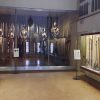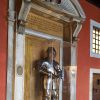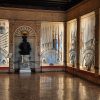The rooms of the Armoury contain a valuable historical collection of weapons and armaments from several sources. The core of the collection is already documented as existing in the 14th century; and at the time of the Republic the Armoury, under the control of the Council of Ten, was stocked with weapons that would be readily available for the Palace’s guards. On particularly delicate or important occasions, these guards might be joined by the arsenalotti, the highly-trained workforce from the shipyards of the Arsenale (e.g. when a Doge died, all the gates to the Palace were sealed and placed under the guard of the arsenalotti). Comprising various valuable pieces, the collection of arms was partially dispersed after the fall of the Republic, but it still contains over 2000 exhibits. These include very famous examples of 15th and 16th century suits of armour, along with swords, halberds, quivers and crossbows. These often bear the inscribed or painted monogram CX – for “Council of Ten” – which also appears on the door jambs; further evidence of the might of the Council. The Turkish pieces are also interesting; comprising weapons, standards and ships’ lanterns, these were taken from the enemy during battle. Other pieces in the collection include: extraordinary examples of 16th and 17th century firearms; implements of torture; a chastity belt; and a series of small but lethal weapons that were prohibited by law.
Room I. This first room is known as the Gattamellata Room as it contains a finely-chased suit of armour which once belonged to the condottiere Erasmo da Narni, who was nicknamed Il Gattamelata. There is also a series of other, heavy and light, 16th century suits of armour for horsemen and foot soldiers, as well as other suits used in tournaments. One curiosity is the miniature suit of armour founded on the battlefield at Marignano in 1515, which may have been for a child or a dwarf. The room also contains a variety of swords from various periods and a number of cross-bows, with their typical quivers in painted or embossed leather. The ship’s lamps decorated at the top with a crescent-moon motif were seized in battle from Turkish ships.
Room II. The main feature here is another Turkish artefact: the triangular standard taken at the famous Battle of Lepanto in 1571. The borders are embroidered with verses from the Koran, whilst the inscription in the centre renders homage to Allah and his prophet Mohammed. There is also a noteworthy suit of armour which Henri IV of France donated to the Republic in 1604. Other items in this room are 15th century armoured protection for horses’ heads; some large swords and two richly-decorated halberds.
Room III. This takes its name from the bust of Francesco Morosini in a niche at the end of the room. A Venetian admiral, Morosini became supreme commander of the Venetian fleet during the 1684-1688 war against the Turks, and his re-conquest of the Peloponnese would lead to him being known as Il Peloponnesiaco. Elected Doge in 1688, Morosini’s military victories were such that he was the only person in the entire history of the Venetian Republic to be honoured with a public monument whilst still alive. This room contains numerous swords, halberds, crossbows and quivers that are either inscribed or painted with the letters CX, initials which also appear on the doorjambs – all confirming the extensive power of the Council of X. Another noteworthy piece is the culverin, a small finely-decorated cannon dating from the middle of the 16th century. The twenty-barrel harquebus, with 10 long and 10 short barrels, may be considered a predecessor of the modern machine-gun.
Room IV. This room contains a extraordinary examples of 16th and 17th century firearms. There is also a lethal “devil’s chest” that fired off four hidden pistols when opened, and a poisoned arrow. The collection includes some instruments of torture as well, together with a chastity belt and some weapons that were forbidden because they were so small they could be hidden about the person (all these once belonged to the Carrara family of Padua, which Venice conquered in 1405).






